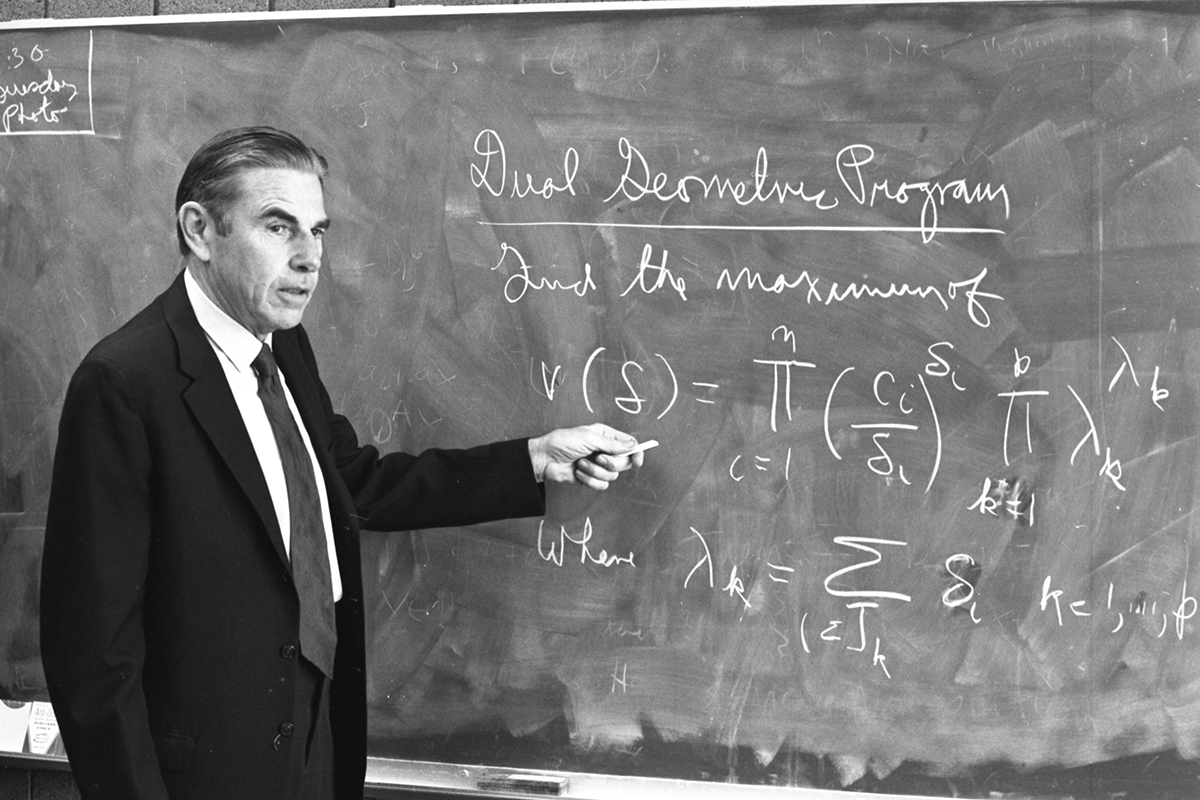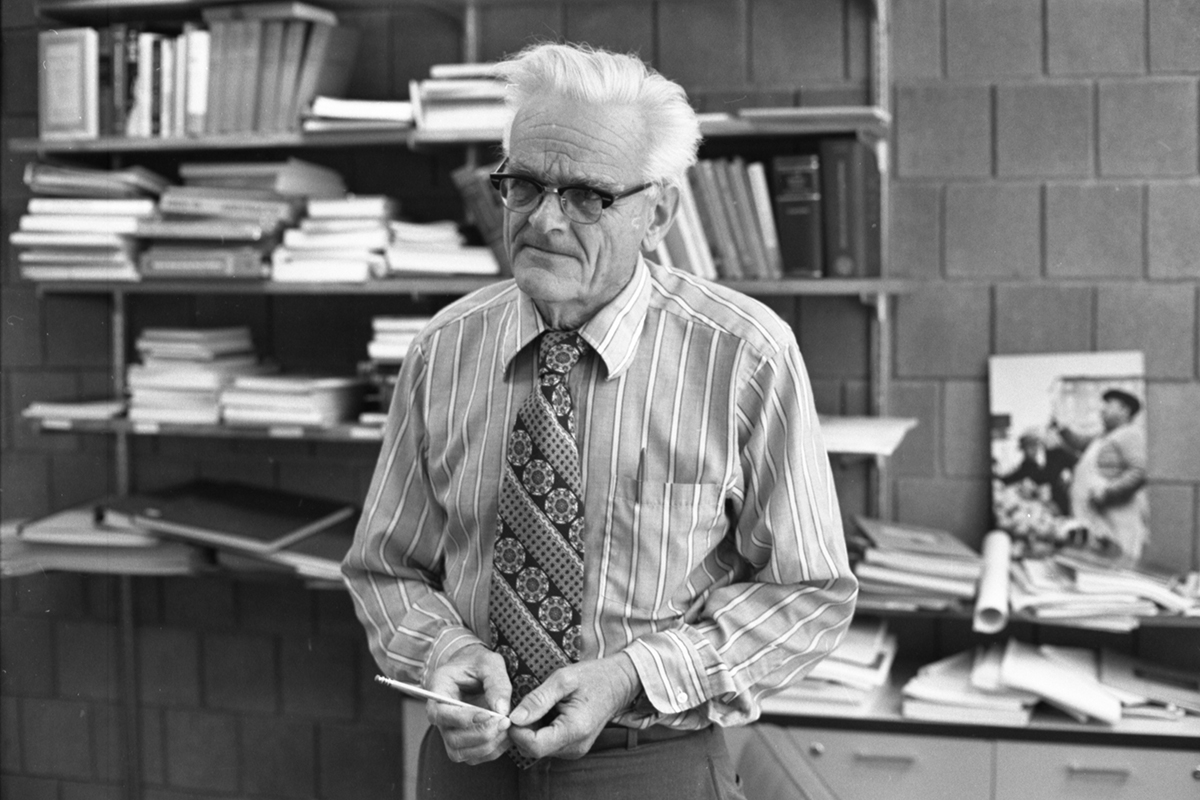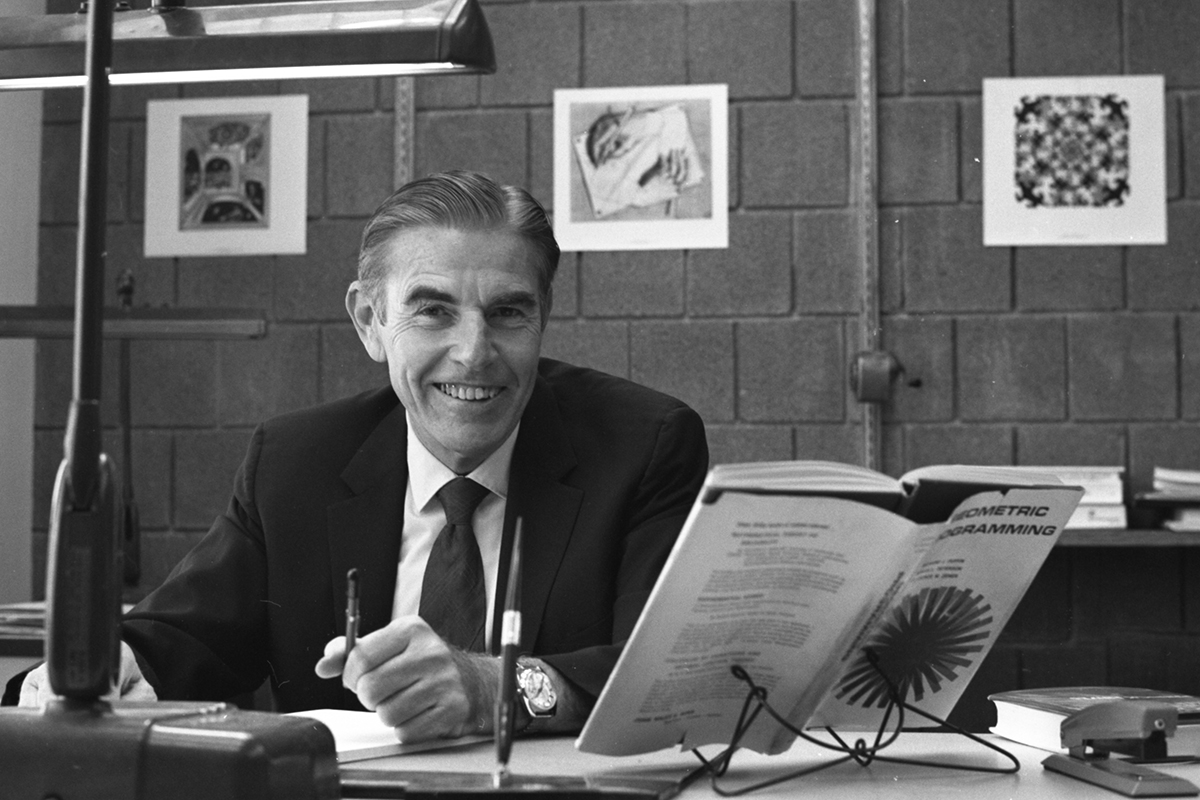
by Sarah Bender
Carnegie Mellon is home to a number of groundbreaking advancements in physics and mathematical sciences. The University Archives documents more than 100 years of innovative and impactful history across CMU — including the Clarence Melvin Zener Collection.
Physics professor Zener, along with his colleague, mathematics professor Richard Duffin, influenced a generation of scientists and mathematicians during their tenure at CMU — from Nobel Prize winners and Wolf Prize winners to department heads. Through their own work, they revolutionized operations research and modern electronics, kickstarting the discipline of geometric programming and laying the foundation for countless new fields and future innovations.

The Clarence Melvin Zener Collection
Zener was a physics professor at CMU from 1968 until his death in 1993. Before coming to CMU, he taught at a number of other institutions, including the University of Chicago and Texas A&M University, where he served as the dean of its College of Science. He held an A.B. from Stanford University and a Ph.D. in physics from Harvard University.
Throughout his career, Zener was known for his ability to jump into a new field, quickly identify critical issues and begin offering contributions almost immediately. As early as the 1930s, he set the stage for future breakthroughs. He discovered an electrical effect that he introduced to the world in a paper published in 1934, which led to the development of a voltage regulator — created at Bell Labs, and named the Zener diode in his honor. The semiconductor device is used in everything from surge protectors to smartphones today.
Next, he found a problem that nobody had yet explored — internal friction, the process by which the energy in a vibrating metal turns to heat as it fades. Zener began to lay the foundation for understanding the phenomenon, becoming the first scientist to characterize the process. As a result, internal friction evolved into a major field of study.
Another concept developed by Zener is ocean thermal energy conversion — a low-cost, pollution-free form of solar energy that harnesses temperature differences between the surface of the ocean and deeper waters. He also made revolutionary discoveries in metallurgy, conducted research in ferromagnetism and elasticity, and worked with the Watertown Arsenal during World War II, and the Westinghouse Electric Corporation Research Labs over a period of 14 years.
Zener was the author of more than 125 papers and books — many of which are a part of Carnegie Mellon’s collection. He won a number of awards, including the John Price Wetherill Medal from The Franklin Institute, the Gold Medal from American Society for Metals, and the Von Hippel Award from the Materials Research Society. The Archives holds 12 of his approved U.S. patent applications from the 1970s and 1980s.

Zener and Duffin
Duffin began his career at the University of Illinois Urbana-Champaign, where he earned both his bachelor's degree and a Ph.D. He joined then-Carnegie Institute of Technology, now known as Carnegie Mellon, in 1946, after a stint lecturing at Purdue University and a wartime role with the Carnegie Institute in Washington, D.C. — where he worked on navigational equipment and mine-detecting technologies.
At CMU, Duffin worked on problems and authored publications involving graphs and networking, mathematical programming, differential equations and mathematical modeling. At the same time, he worked as a consultant with Westinghouse.
Duffin began to collaborate with Zener in Pittsburgh. Together, they pioneered the discipline of geometric programming. They worked alongside Elmor L. Peterson, a student in Carnegie Mellon’s Department of Mathematical Sciences, to simplify the process of “optimizing” a system of problems with this new problem-solving technique. Their first paper on the subject was published in 1967, and they went on to make further developments, which were useful for both pure mathematical studies as well as practical engineering and business administrative problems.
Peterson, who received his bachelor’s degree in 1960, master’s degree in 1961, and Ph.D. in 1964, was a student of Duffin’s and wrote his dissertation under Duffin’s mentorship. He recalls a professional relationship with the two scientists that began several years before their work in geometric programming.
“Duffin got me a job at Westinghouse Electric during the final year of my Ph.D., starting in the fall of 1963,” he said. “Instead of working as a teaching assistant on campus, I was able to gain experience in the industry. And since Duffin was a consultant out there, one day a week, he would come out and have lunch with me.”
It was during one of these lunches that Duffin introduced Peterson to Zener, who was the director of science for the entire company. Zener took an interest in Peterson — the two shared a dislike of experimental physics and preferred the theoretical. In the coming weeks, Zener stopped by Peterson’s office for help solving complex math problems. When one such problem revealed a new physics law about the wires inside transformers, Zener included Peterson in the subsequent publication.
“What I would expect from most people is a footnote under the author, and then in the footnote he would thank me for the help I gave him,” Peterson said. “But do you know what Zener did? He actually put me on there as an author of that paper — not just himself, but the two of us. And since ‘Peterson’ comes before ‘Zener’ in the alphabet, it was: ‘Elmor L. Peterson and Clarence Zener.’ So I had co-authored a paper like that before I even took my Ph.D. exam.”

Spheres of Influence
Zener and Duffin’s impact resonated far beyond their own discoveries. Through the students they mentored over the years, their influence impacted concepts in math and physics they never had the chance to explore.
At the University of Chicago, Zener advised John B. Goodenough. Goodenough was a materials scientist, a solid-state physicist and eventually a Nobel laureate in chemistry. He was 97 years old when he received the Nobel Prize in 2019 — the oldest person in history to do so.
He also advised Arthur Nowick, a materials scientist who worked in internal friction. Nowick authored more than 200 publications, advised nearly 30 Ph.D. students, and held at least 12 patents.
In addition to teaching Peterson, Duffin advised Raoul Bott, who received his Ph.D. in mathematics from CMU in 1949 and an honorary degree in 1989. Among his recognitions were the National Medal of Science, the Wolf Prize and the Oswald Veblen Prize in Geometry by the American Mathematical Society. The Bott-Duffin method, which introduced a tool called the “constrained inverse” of a square matrix, is named for their collaboration.
Duffin is also known for his connection with another student, for whom he wrote a famous letter of recommendation for Princeton that simply said: “He is a mathematical genius.”
This student was mathematician John Nash — who went on to receive the Nobel Prize in Economics for his work analyzing equilibrium in the field of non-cooperative games, popularly known as the Nash equilibrium. Nash, who received his bachelor’s and master's degrees from the Mellon College of Science in 1948 and an honorary degree in 1999, also predicted key concepts of modern cryptography and advanced differential geometry, partial differential equations, and more.
“Duffin and Zener were two of the greatest influences in my life,” said Peterson, whose career in mathematical science and engineering was shaped by his experiences with the scientists. “I was lucky to know them extremely well, both as researchers and as people.”
Zener’s papers are available in the Archives for use by researchers. Contact the Archives to schedule an appointment, or visit during drop-in hours on Thursdays 10:00 a.m. – 4:00 p.m.
